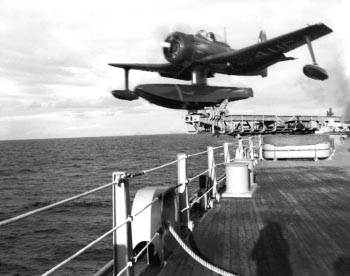![]() The Pacific War Online Encyclopedia
The Pacific War Online Encyclopedia
|
| Previous: SBD Dauntless, American Dive Bomber | Table of Contents | Next: SC Search Radar |

National Archives #80-G-399644
Curtiss SC-1 Seahawk
| Crew |
1 |
| Dimensions | 41'-" by 36'4" by 15'0" 12.50m by 11.08m by 4.88m |
| Wing area | 280 square feet 26 square meters |
| Weight | 6320-9000 lbs 2867-4082 kg |
| Maximum speed | 313 mph at 28,600' 504 km/h at 8717m |
| Cruise speed |
130 mph 209 km/h |
| Climb rate | 42 fps 12.7 m/s |
| Service ceiling | 37,300' 11,370m |
| Power plant | One 1350hp (1007 kW) Wright R-1820-62 Cyclone nine-cylinder radial engine driving a four bladed propeller |
| Armament | 2 0.50 machine guns |
| External stores | 650 lbs (295 kg) bombs or depth charges |
| Range | 1090 miles 1754 km |
| Production |
At Columbus, Ohio: 563 SC-1 from 1944-10 10 SC-2 |
| Variants |
The SC-2 had a 1425hp (1063 kW) R-1830-76 engine, improved canopy, and provisions for a passenger. |
The Curtiss SC Seahawk was intended to replace the SOC Seagull used on U.S. cruisers during the Pacific War. Like most other U.S. seaplanes, the aircraft were delivered with fixed undercarriages to allow it to operate from carriers and airfields, and these were replaced with pontoons as needed by the Navy.
The design came out of a June 1942 requirement for a seaplane with improved performance. Curtiss' design was approved in October 1942, and the Navy was so anxious for the new seaplane that a contract was placed for 500 units in June 1943, even though the first prototype did not fly until 16 February 1944. The Seahawk did not see combat until June 1945 over Borneo. Though 950 units were eventually ordered, production ceased with the surrender of Japan, and the remaining units ordered were canceled. Only a small number of units were retained in service after the war.
A novel feature was a bomb bay within the central float, which also could carry additional fuel.
References
aviastar.org (accessed 2012-1-4)
The Pacific War Online Encyclopedia © 2011 by Kent G. Budge. Index